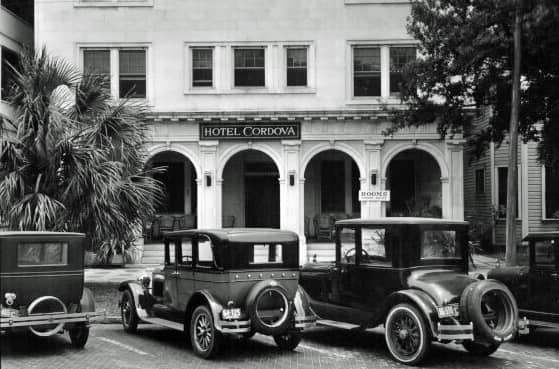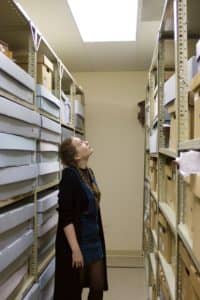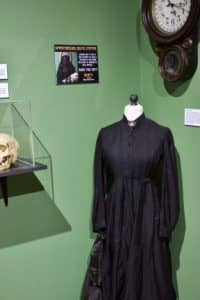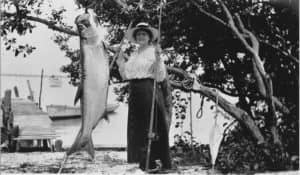Where ominous shadows lurk in the Sunshine City

Within the 100-year-old walls of the St. Petersburg Museum of History are memorabilia from former travelers and residents, vintage artifacts and advertisements and a replica of one of St. Petersburg’s notorious green benches.
St. Petersburg, also known as the Sunshine City for its Guinness World Record of 768 days of consecutive sunshine, claimed to be the greatest destination in the world, and for affluent members of high society, it was.
But with the radiant sunshine come the equally daunting shadows of St. Petersburg’s sometimes turbulent past.
As the archives and collections specialist at the museum, Jessy Breckenridge sees – and feels – a lot. “If you stand still, you can hear footsteps,” she whispers.

Jessy Breckenridge is archives and collections specialist at the St. Petersburg Museum of History. Photo: Lauren Wood.
An unfamiliar energy emerges as the room goes quiet. Footsteps pace back and forth above the ceiling, trailing the length of the brimming collections vault. The room is packed high and overflowing with handmade clothes, 100-year-old dolls with human hair, medical specimens and other personal treasures and oddities from residents’ past.
“Every time I come in here, someone starts walking,” Breckenridge said.
With thousands of unique items in the museum, there isn’t much Breckenridge hasn’t come across since 2019. Medical saws and scalpels from the Civil War. Human skulls with reattached teeth. A 1925 two-headed, six-legged calf. A 1900 mourning gown – one that seems to frequently misplace itself.
Breckenridge first discovered the unsettling dress when pulling artifacts for the odditorium’s Halloween display. Black in color and worn without jewelry, mourning gowns symbolized spiritual darkness and despair after losing a loved one in the Victorian era.
Once Breckenridge placed the gown on the mannequin, she locked it in the collections office and left for the weekend. When she came back on Monday, it was thrown in the hall.
“I had assumed that maybe one of the maintenance staff, one of our facility staff, had moved it. I don’t know why they would move it. They usually don’t touch anything up here … there was no reason for them to have moved it,” Breckenridge said.

The museum’s Victorian mourning gown. Photo by Lauren Wood.
Later that afternoon, Breckenridge found it in the archives vault, a separate locked room in the museum. She confronted the curator about the misplaced dress, who denied interacting with it that day.
She soon set out on a quest to locate the perpetrator of the moving gown. With minimal findings, Breckenridge returned back upstairs, where she was quickly confronted by a frightened museum volunteer. “He was like, ‘Tell me it was you. Tell me that you moved it,’” Breckenridge said.
When she asked him what he was referring to, he pointed to the dress. It was positioned in the middle of the hall, facing the open room.
“Because the mannequin is also from that time period, the wheels that it has on the bottom are stuck. So, you have to physically pick it up and move it, or else it makes noise,” Breckenridge said. “There was no noise. It’s very strange, very unsettling.”
Besides the mysterious moving gown, Breckenridge also has difficulty with the museum’s Little Cooperstown baseball exhibit. Despite its friendly and inviting outward appearance, Breckenridge refuses to walk through the labyrinth-like room or even acknowledge it after dark.
“It’s in the newest part of the museum which is still, you know, about 20 years old,” Breckenridge said. “But there’s always something in the shadows. I’ve seen like, full-on figures in the dark. The shadows are darker there where they maybe should not be.”
Little Cooperstown includes the world’s largest collection of autographed baseballs. It houses 5,000 baseballs in a permanent display of towering plexiglass shelves, creating a maze throughout the two-room exhibit.
“Part of the reason that I joke about running through it … It isn’t just like, ‘I feel like I’m not alone,’ but it’s definitely like feeling hunted a bit. Like I’m being chased,” Breckenridge said.
The third and most recognizable presence within the building is Mary Wheeler Eaton, the original founder of the history museum. Both Breckenridge and Executive Director Rui Farias say they often feel Eaton’s presence.
Eaton was a well-established and devoted member of the community. In 1920, she helped create the first St. Petersburg Memorial Historical Society.
Nine years later, Eaton fell ill with pneumonia while caring for her husband and died. Her husband passed away 13 days later.
“I’ve been sitting here talking to somebody after hours, and you can hear doors close, and I know no one’s in the museum, or you can hear someone walking down the hall. And now it doesn’t even bother me anymore,” Farias said.
Breckenridge recalls one employee’s encounter with Eaton during Hurricane Irma in 2017. The facility’s manager and family had stayed in the museum during the storm, and the children were allowed to play upstairs in the museum. They soon came running down, claiming they’d been chased by a woman in white.
“They start looking around. They come up here, and the kids point to this painting in the collections. It is indeed of a woman in white,” Breckenridge said.
Breckenridge was informed of this encounter after she began working at the history museum in 2019. Both Farias and Breckenridge did not know that the portrait was of Eaton until Breckenridge discovered an antique museum brochure with a photo of the late founder.
“We didn’t know that that portrait was of her. Now we do, and we moved it downstairs,” Breckenridge said. “Every night, I say goodnight to it. Just in case she decides she’s not done talking to me.”
“I’m convinced that she’s still here. Just like I have every intention of coming back when I die, I want to make sure people take care of this museum,” Farias said.

Mary Wheeler Eaton. Collections, St. Petersburg Museum of History.
Farias created and taught Pinellas County’s first Florida History class for St. Petersburg High School. For 20 years, he educated students about St. Petersburg’s unique history, including the rumored indigenous burial mounds underneath the city.
“There were 20,000 Tocobagans who lived in this part of Florida, and basically everywhere from Weedon Islands of the Gandy area all the way around the St. Pete Peninsula, there were mounds everywhere,” Farias said. “But that doesn’t mean they are burial mounds. They could just be refuge mounds.”
Farias noted that the first inhabitants of this area lived off the sea and would discard fish, oysters and clams in large piles. They would also bury the deceased, piling shells and sand on top to form a burial mound.
Roser Park, St. Petersburg’s first residential subdivision established in the early 20th century, was built on top of these historic mounds. They also lie underneath Central Avenue in the downtown district.
Denielle Kennett, owner and founder of the “haunted tour” business St. Peter’s Ghosts, said, “Some places are just bad. There’s a Stephen King quote that says ‘the ground is sour,’ and I think that applies to a lot of places in St. Pete. But I also believe some places are just naturally good, like the Cordova. It just has a really cool energy to it.”
The St. Peter’s Ghosts tour provides attendees with historical and haunting anecdotes from various sites in the district. These include the Vinoy, the Blocker home, the Museum of History and the Cordova Inn.
First known as Hotel Scott, the Cordova was built in 1921 during St. Petersburg’s exponential economic and residential boom. In 1923, it was renamed Hotel Cordova and was home to the Cordova family and staff until the 1950s.
“This was their home originally, and what they did was they lived on the top floor and they rented out the bottom rooms,” Kennett said.
The European Art Deco style hotel boasts grand archways, 32 spacious rooms, and a longtime personal concierge known to travelers, staff and locals as Major-domo, the Cordova family butler.
“He was the family butler and then became the butler for the whole Hotel Cordova. He died in the hotel, but people will still see him literally in like full-gown,” Kennett said. “It’s never aggressive. It’s never negative.”
Kennett described the unnamed Major-domo’s spirit as a residual haunting, where the spirit may not realize that they have passed. Instead, they will continue performing their daily duties and routines as though they still live in the present.
“They’ll see someone carrying luggage, and they’ll go and ask for help. And then he’s gone,” Kennett explained.
Kayla Bentley has worked as a front desk agent for the Cordova Inn for six months. Although she hasn’t experienced too much abnormal activity during the day, she does recall a few interactions with the Cordova’s paranormal guests.
“There was an instance with room 305. I had walked in to inspect the room, and it seemed like somebody was sitting on the bed in the moment … So when I walked in, and the door opened, the impression disappeared and the mattress rose,” Bentley said.
Like the Cordova Inn, many historical sites throughout St. Petersburg still preserve their original design to draw visitors back to the early 20th century, a perfect meeting ground for both past and current guests.
While the city has undergone immense eclectic and progressive changes since 1920, it’s still vital to remember and celebrate those who were here then.
“It’s important to know where we came from, to see where we’re going. We weren’t always this tourist mecca. We weren’t always this cool inclusive town,” Farias said.
“There are stories that need to be told, and not in such a way like, ‘look how awful we were.’ But just to remember, ‘look how far we’ve come.’”







